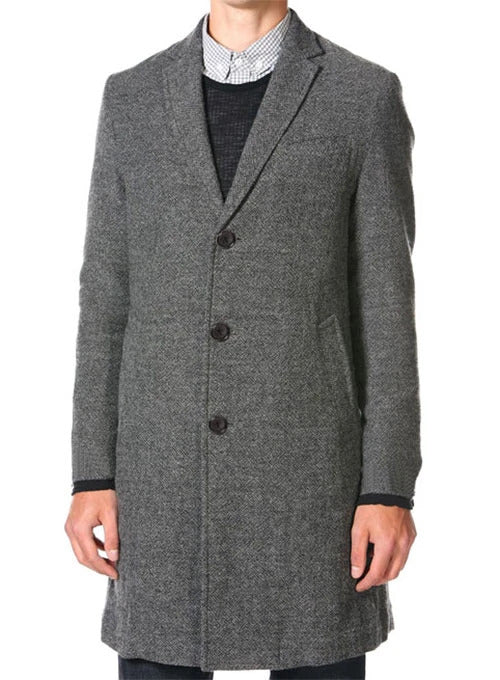When shopping for outerwear, you may come across overcoats. They've been around for centuries, with some of the earliest styles of overcoats originating in the 1600s. Overcoats aren't ordinary jackets, however. While jackets are considered outerwear as well, overcoats feature a unique design. What is an overcoat exactly?
Overcoats Defined
An overcoat is a type of formal or semi-formal coat that extends past the waist when worn. They are known as "overcoats" because they are designed to be worn over your entire outfit. Overcoats are attractive, comfortable and easy to maintain. Assuming you're trying to create a formal or semi-formal outfit, you can't go wrong with an overcoat.
Common features of overcoats include the following:
- Long length
- Formal or semi-forma style
- Thick construction
- Made of a soft fabric
- Can be worn over other jackets
Overcoats vs Jackets: What's the Difference
There are a few key differences between overcoats and jackets. Nearly all overcoats extend past the waist when worn. Some of them may extend to your thighs when worn, whereas others may extend all the way to your knees when worn. Jackets, in comparison, have a shorter length. Most jackets only extend to your waist when worn.
Overcoats are designed to be worn as the outermost garment in a given outfit. This may or may not be true for jackets. You can often wear a jacket under another piece of outwear. When wearing a suit, for example, you might want to wear an overcoat. You can wear an overcoat over your suit jacket. You shouldn't, however, try to wear a suit jacket over your overcoat.
Most overcoats also feature a thick construction. They are typically constructed of thick wool or tweed. With their thick construction, they are exceptionally warm. You can wear an overcoat during the fall and winter months to protect against the cold weather. While jackets can provide some level of warmth, they usually feature a thinner construction than their overcoat counterparts. And because they are thinner, jackets aren't as warm. These are just a few differences between overcoats and jackets.

Different Types of Overcoats
There are different types of overcoats. Trench coats, for instance, are considered overcoats. Trench coats are heavy-duty coats that, like all types of overcoats, are designed to be worn as the outermost garment in a given outfit. Trench coats are typically waterproof, however. With a trench coat, you can rest assured knowing that neither you nor your outfit will get wet -- even if it's raining outside.
Peacoats are also considered overcoats. Peacoats were originally worn by sailors, but they've since made their way into the world of mainstream fashion. Most peacoats feature a thick woolen construction while exhibiting a formal or semi-formal style. Peacoats, however, are usually shorter than most other overcoats. Most overcoats extend past the waist when worn, but peacoats typically extend right at the waist (or slightly below the waist).
Chesterfield coats are overcoats. What is a Chesterfield coat? It's a type of Victorian-era overcoat that's designed to fit somewhat loosely when worn. Other types of overcoats offer a more form-fitting construction. Chesterfield coats are different in the sense that they are fit more loosely. Trench coats, peacoats and Chesterfield coats are all considered overcoats.
You can find overcoats in custom sizes. Custom-sized overcoats, such as those sold here at StudioSuits, don't use generic measurements. Rather, they use custom measurements that you specify. You can specify your body measurements when ordering a custom-sized overcoat. As long as you provide accurate measurements, your overcoat will fit perfectly.
Single- vs Double-Breasted Overcoats
Overcoats are available in single-breasted and double-breasted styles. You can distinguish between these two styles by inspecting the buttons. All overcoats have buttons on the front. Single-breasted overcoats, though, have a single column of buttons. Double-breasted overcoats, conversely, have two columns of buttons.
You can choose either a single-breasted overcoat or a double-breasted overcoat. Single-breasted overcoats offer a sleeker and more modern appearance. Double-breasted overcoats offer a more traditional appearance. Regardless, overcoats are available in both styles.
Aside from the buttons, there's no real difference between single-breasted and double-breasted overcoats. Single-breasted overcoats simply have one column of buttons, resulting in a smaller section of overlapping fabric when the buttons are fastened.
Tips on Wearing an Overcoat
There are a few tips you should consider following wearing an overcoat. For starters, make it your outermost garment. You shouldn't wear any other garment over your overcoat.
Overcoats receive their namesake from their use as the outermost garment in a given outfit. This is due to the fact that they are thicker and heavier than most other jackets and coats. If you wear another jacket or coat over your overcoat, your outfit will probably look puffy. For a cleaner and more uniform style, you should wear the overcoat as the outermost garment.
Because they are typically made of wool, overcoats can attract lint. The good news is that lint won't damage or degrade your overcoat. Nonetheless, it can create a messier appearance that lowers the aesthetics of your overcoat. Before putting on your overcoat, inspect it for lint. If you see lint on your overcoat, you can remove it using a lint roller. A lint roller will pick up the stubborn lint so that it doesn't harm your overcoat's aesthetics.
Don't forget to wear the right shirt and trousers with your overcoat. You should choose a shirt and trousers that complement the color of your overcoat. They don't have to feature the exact same color. It's perfectly fine to choose a shirt and trousers in a completely different color. Nonetheless, your overcoat should complement these garments. If the colors clash with each other, you'll struggle to create a uniform outfit.
You may want to accessorize your overcoat. When wearing it during the winter, for example, you can accessorize your overcoat with a scarf. A scarf will add a new visual element to your outfit while helping to define your neckline.



